Tropical cyclone verification northern hemisphere 2022
A summary of tropical cyclone activity in the Northern Hemisphere for the 2022 season together with an assessment of the performance of the Met Office global model in predicting the track and intensity of these tropical cyclones.
1. Introduction
A summary of tropical cyclone activity in the Northern Hemisphere for the 2022 season is presented below together with an assessment of the performance of the Met Office global model in predicting the track and intensity of these tropical cyclones.
Tropical cyclones are experienced in the North Pacific, North Atlantic and North Indian Oceans and nearby tropical seas with occasional tropical or subtropical storms in the Mediterranean Sea. For the purpose of tropical cyclone verification the northern hemisphere is divided in to five basins; the North-West Pacific (west of 180° E to the Malay Peninsula), the North-East Pacific (east of 180° E), the North Atlantic, the North Indian Ocean (west of the Malay Peninsula) and the Mediterranean Sea. Mean error statistics for the four main basins are presented together with a table of statistics for the whole Northern Hemisphere. Verification is performed at 12-hour intervals up to forecast time T+168, although statistics are only presented at 24-hour intervals in this report. The global model resolution in operation was 0.140625° x 0.09375° x 70 levels. This is equivalent to a horizontal resolution of 16 km × 10 km at the equator.
Tropical cyclone forecast verification - measures of error
Advisory positions received in real time from RSMC Tokyo, JTWC Hawaii, NHC Miami and CPHC Honolulu are used as verifying observations of storm location. Best track data from these centres will be obtained once they become available. Past experience shows that use of best track rather than real time data usually only makes minor differences to seasonal error statistics. Some mean error statistics for last season are also included for the purposes of a comparison. Forecast tracks are only verified when a depression reaches tropical storm status.
2. Tropical cyclone activity
| NWP | NEP | NAT | NI | MED | TOTAL | |
|---|---|---|---|---|---|---|
| Tropical depressions (<34 knots) | 5 (6) | 0 (0) | 2 (0) | 0 (0) | 0 (0) | 7 (6) |
| Tropical storms (34-63 knots) | 13 (13) | 8 (11) | 5 (14) | 6 (3) | 1 (2) | 33 (43) |
| Hurricanes/typhoons (>63 knots) | 12 (10) | 10 (8) | 8 (7) | 1 (3) | 0 (0) | 31 (28) |
| Total | 30 (29) | 18 (19) | 15 (21) | 7 (6) | 1 (2) | 71 (77) |
Categories assigned based on 1-minute averaged winds
Basin name abbreviations:
NWP : North-west Pacific (west of 180° E)
NEP : North-east Pacific (east of 180° E)
NAT : North Atlantic
NI : North Indian (west of Malay Peninsula)
MED : Mediterranean Sea
The number in brackets indicates the figure for the 2021 season.
3. Summary of northern hemisphere storms
3.1 North-west Pacific basin storms
| T+0 | T+24 | T+48 | T+72 | T+96 | T+120 | T+144 | T+168 | |
| Possibly verified | 172 | 126 | 94 | 65 | 44 | 30 | 18 | 12 |
| Detection rate (%) | 99 | 99 | 98 | 97 | 98 | 97 | 94 | 75 |
| AT error (km) | -0.5 | -10.8 | -43.0 | -82.9 | -96.1 | -32.6 | -50.3 | -535.1 |
| CT error (km) | 0.1 | 7.3 | 24.7 | 44.6 | 23.9 | 179.2 | 149.2 | 44.6 |
| Track skill (%) | ***** | 67.4 | 71.5 | 74.1 | ***** | ***** | ***** | ***** |
| * 2017-21 skill (%) | ***** | 62.1 | 69.4 | 69.8 | ***** | ***** | ***** | ***** |
| DPE (km) | 36.5 | 71.0 | 132.4 | 213.8 | 289.1 | 485.2 | 728.9 | 800.7 |
| * 2017-21 DPE (km) | 32.1 | 69.9 | 126.3 | 197.4 | 291.8 | 377.1 | 504.3 | 683.0 |
| Central pressure bias (mb) | 3.1 | 8.8 | 13.7 | 17.6 | 18.6 | 19.3 | 24.2 | 21.6 |
* 5-year running mean DPE and skill for all north-west Pacific storms 2017-21
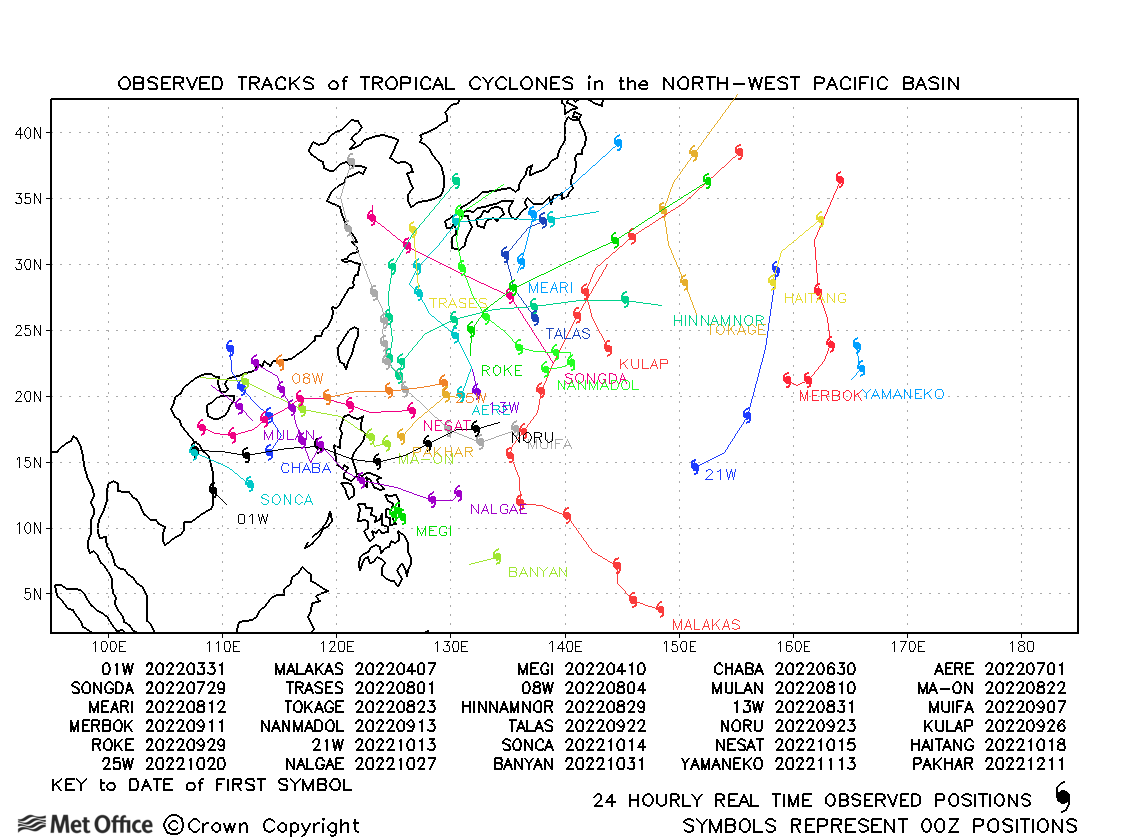
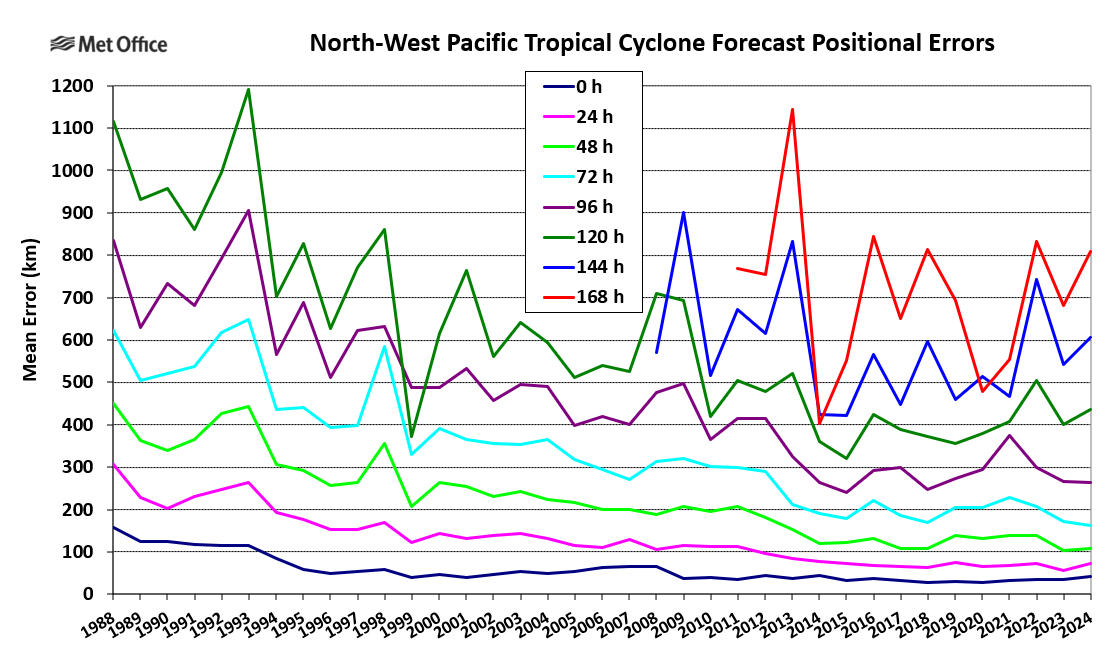
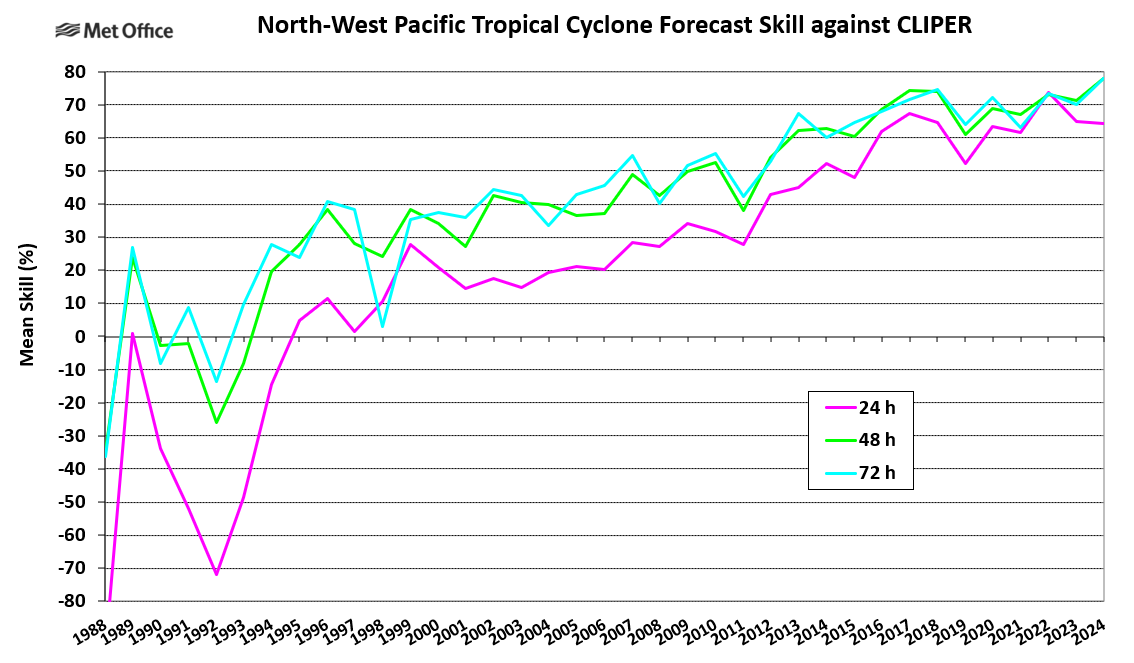
The total number of storms was similar to 2021, but they were shorter lived so there were less verifiable forecasts. Track forecast errors were mostly above the 5-year running mean, particularly at longer lead times. The central pressure bias became increasingly positive (too weak) with forecast lead time.
3.2 North-east Pacific basin storms
| T+0 | T+24 | T+48 | T+72 | T+96 | T+120 | T+144 | T+168 | |
| Possibly verified | 153 | 117 | 86 | 59 | 40 | 25 | 13 | 5 |
| Detection rate (%) | 100 | 97 | 94 | 97 | 90 | 88 | 69 | 40 |
| AT error (km) | 8.1 | 26.4 | 54.0 | 65.1 | 69.9 | 81.5 | 80.9 | 354.0 |
| CT error (km) | -12.2 | -26.6 | -57.4 | -111.9 | -165.9 | -189.0 | -279.0 | -557.0 |
| Track skill (%) | ***** | 55.1 | 52.5 | 53.7 | ***** | ***** | ***** | ***** |
| * 2017-21 skill (%) | ***** | 49.4 | 63.6 | 67.4 | ***** | ***** | ***** | ***** |
| DPE (km) | 33.1 | 68.4 | 130.3 | 195.0 | 260.8 | 275.0 | 368.3 | 758.5 |
| * 2017-21 DPE (km) | 34.5 | 69.8 | 118.3 | 174.1 | 238.8 | 317.7 | 398.5 | 439.3 |
| Central pressure bias (mb) | 1.4 | 6.2 | 10.4 | 10.4 | 7.5 | 7.5 | 5.7 | -3.0 |
* 5-year running mean DPE and skill for all north-east Pacific storms for 2017-21
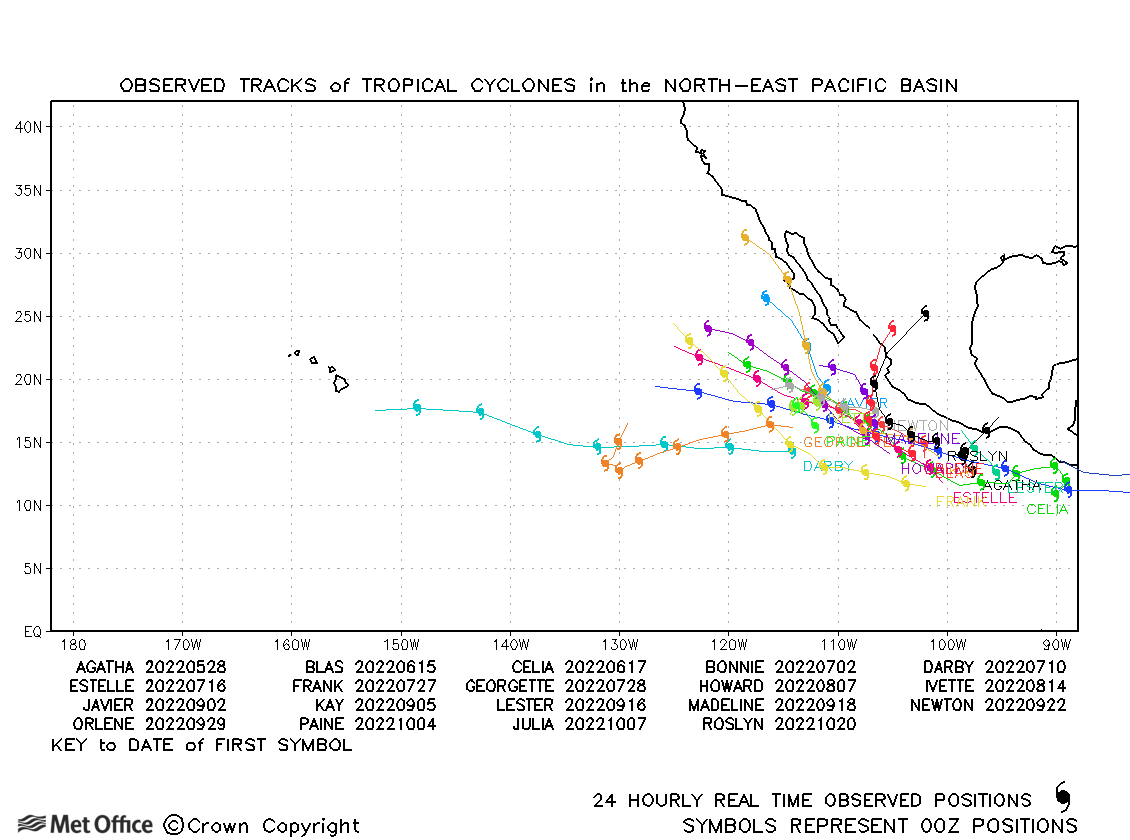
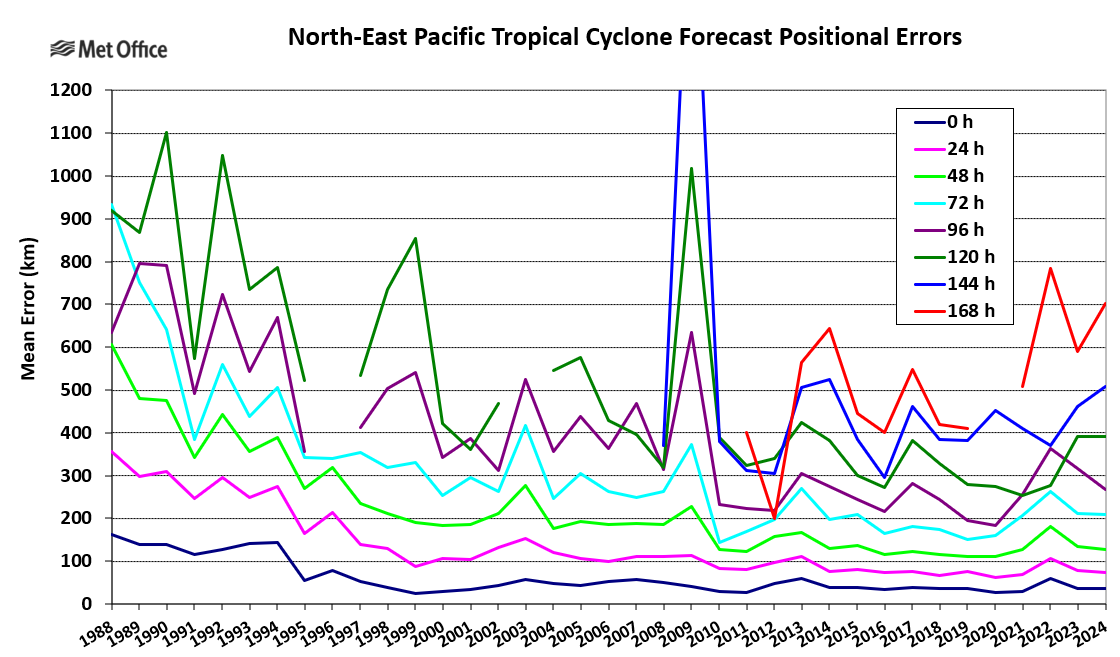
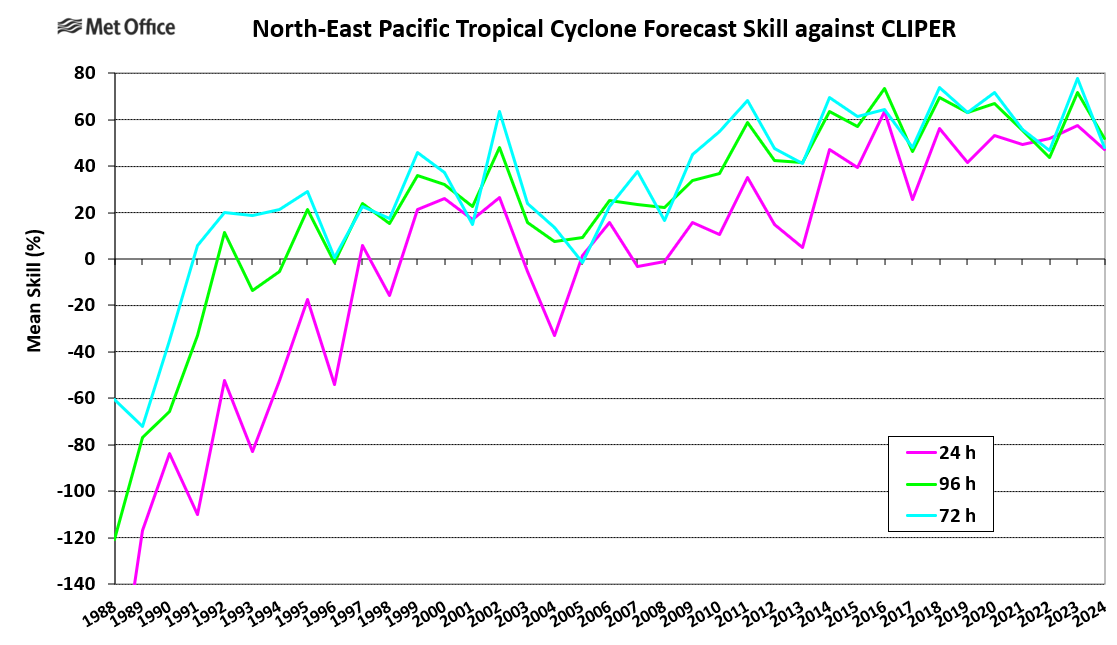
Activity was greater than 2021. Despite a smaller number of tropical cyclones overall, there were more hurricanes and they were longer lived. Track forecast errors were mixed compared to the 5-year running mean. There was a weak central pressure bias at almost all lead times.
3.3 North Atlantic basin storms
| T+0 | T+24 | T+48 | T+72 | T+96 | T+120 | T+144 | T+168 | |
| Possibly verified | 113 | 88 | 67 | 48 | 35 | 25 | 16 | 8 |
| Detection rate (%) | 100 | 100 | 99 | 100 | 100 | 100 | 100 | 100 |
| AT error (km) | -2.5 | -5.5 | -20.8 | -41.4 | -96.7 | -206.7 | -239.8 | -448.9 |
| CT error (km) | -0.3 | 8.5 | 13.2 | 1.1 | 4.8 | 9.6 | 26.4 | 33.8 |
| Track skill (%) | ***** | 77.6 | 83.9 | 80.7 | ***** | ***** | ***** | ***** |
| * 2017-21 skill (%) | ***** | 69.2 | 73.4 | 72.3 | ***** | ***** | ***** | ***** |
| DPE (km) | 25.5 | 50.5 | 78.2 | 122.9 | 194.7 | 351.5 | 516.7 | 659.1 |
| * 2017-21 DPE (km) | 28.6 | 62.1 | 118.1 | 192.4 | 271.5 | 345.4 | 474.3 | 600.8 |
| Central pressure bias (mb) | 4.3 | 7.4 | 11.1 | 14.8 | 16.9 | 18.7 | 22.9 | 39.0 |
* 5-year running mean DPE and skill for all North Atlantic storms for 2017-21
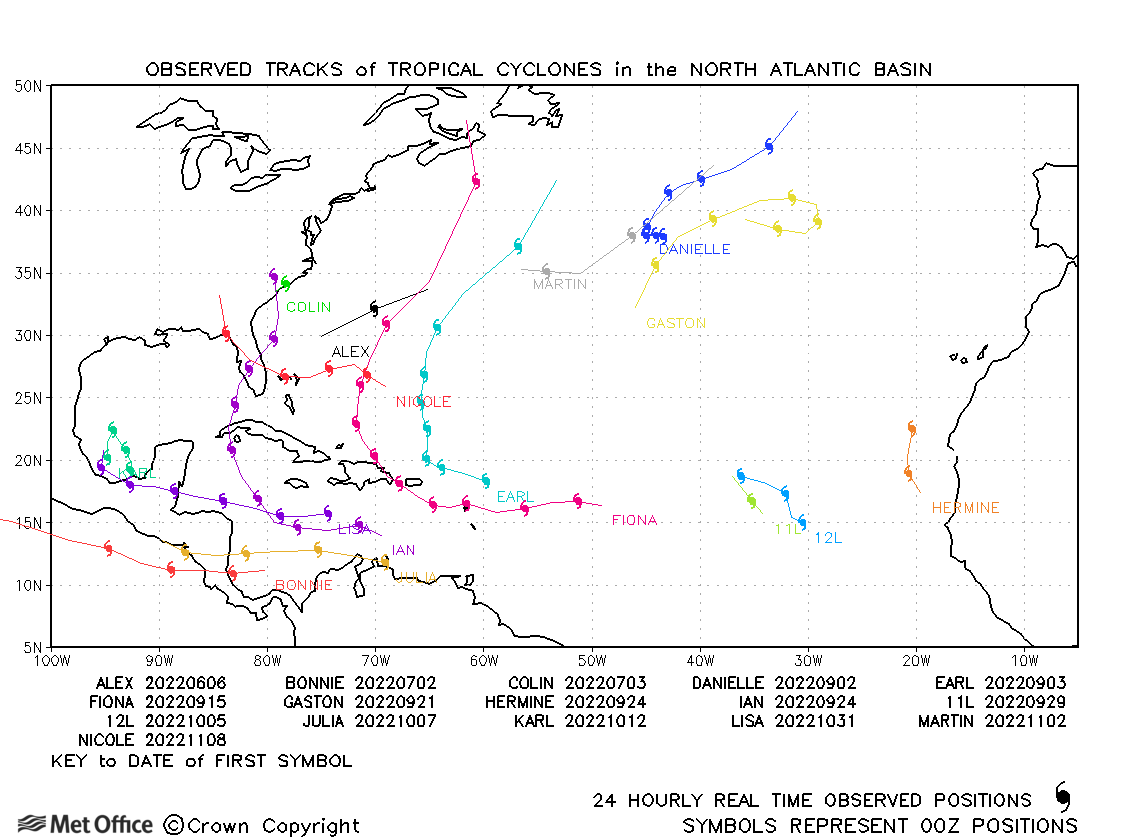
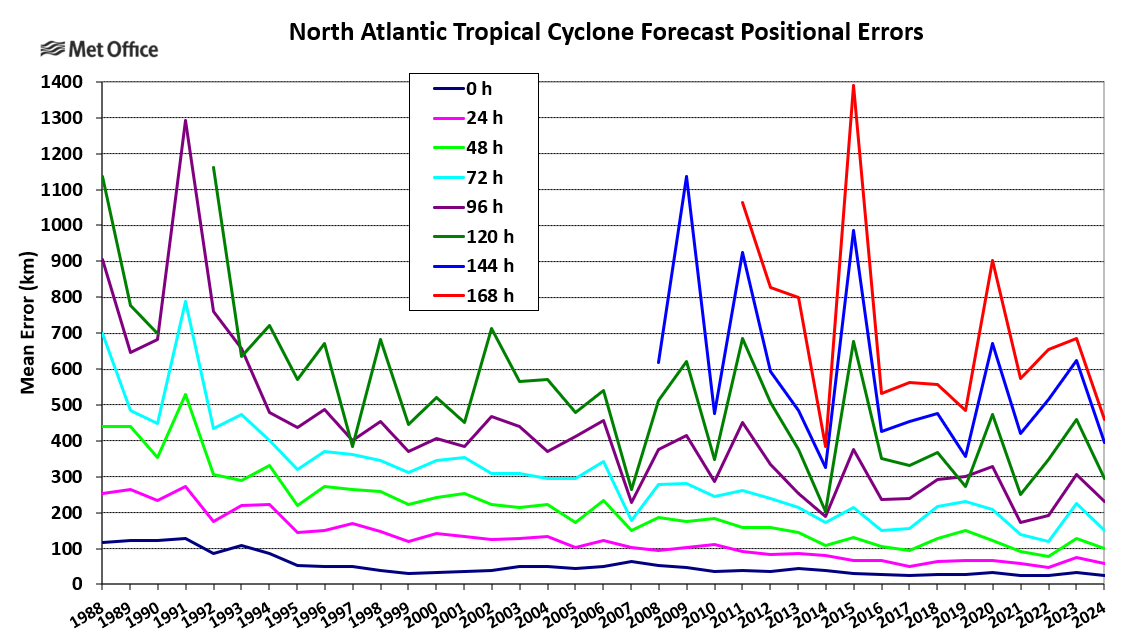
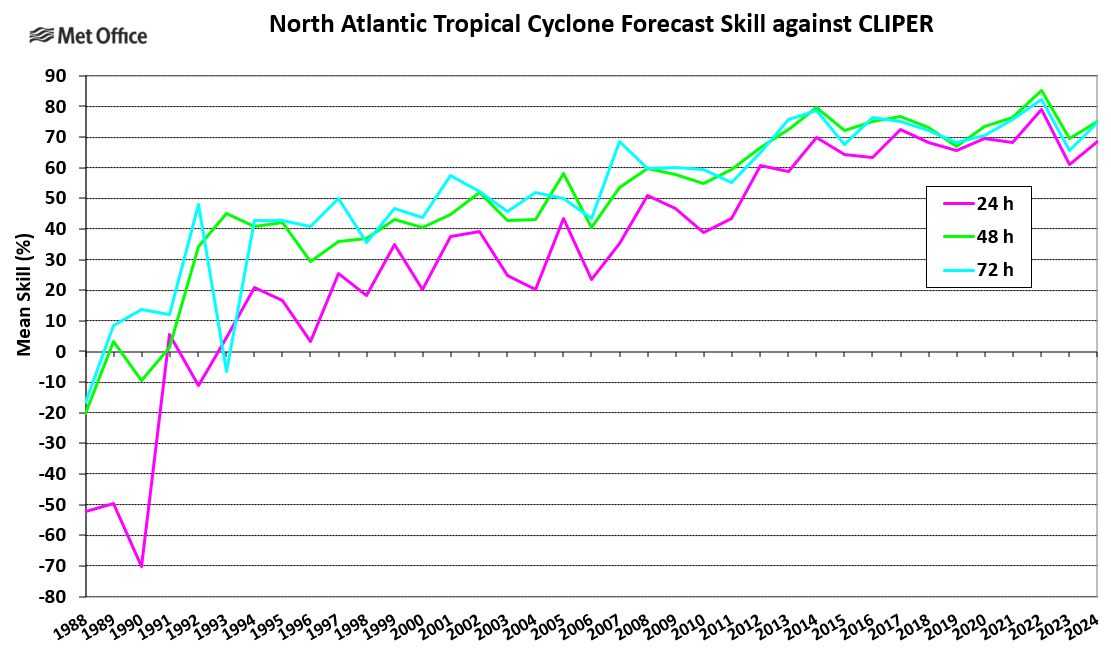
After the active 2020 and 2021 seasons, 2022 was closer to normal, although there were more hurricanes than in 2021. Track forecast errors were lower than the 5-year running mean at short lead times, but higher at longer lead times. There was a growing weak bias throughout.
3.4 North Indian Basin Storms
| T+0 | T+24 | T+48 | T+72 | T+96 | T+120 | T+144 | T+168 | |
| Possibly verified | 25 | 11 | 5 | 3 | 1 | ***** | ***** | ***** |
| Detection rate (%) | 100 | 100 | 100 | 100 | 100 | ***** | ***** | ***** |
| AT error (km) | -5.7 | -32.8 | -63.8 | -155.7 | 493.0 | ***** | ***** | ***** |
| CT error (km) | 2.2 | 34.5 | 133.0 | 168.3 | 204.0 | ***** | ***** | ***** |
| Track skill (%) | ***** | 39.9 | -3.7 | 29.8 | ***** | ***** | ***** | ***** |
| * 2017-21 skill (%) | ***** | 51.0 | 56.5 | 62.2 | ***** | ***** | ***** | ***** |
| DPE (km) | 54.3 | 87.7 | 215.0 | 411.7 | 534.0 | ***** | ***** | ***** |
| * 2017-21 DPE (km) | 42.9 | 75.9 | 128.6 | 181.9 | 244.0 | 357.1 | 527.5 | 605.5 |
| Central pressure bias (mb) | 0.1 | 0.3 | 4.8 | 5.3 | 1.0 | ***** | ***** | ***** |
* 5-year running mean DPE and skill for all North Indian storms for 2017-21
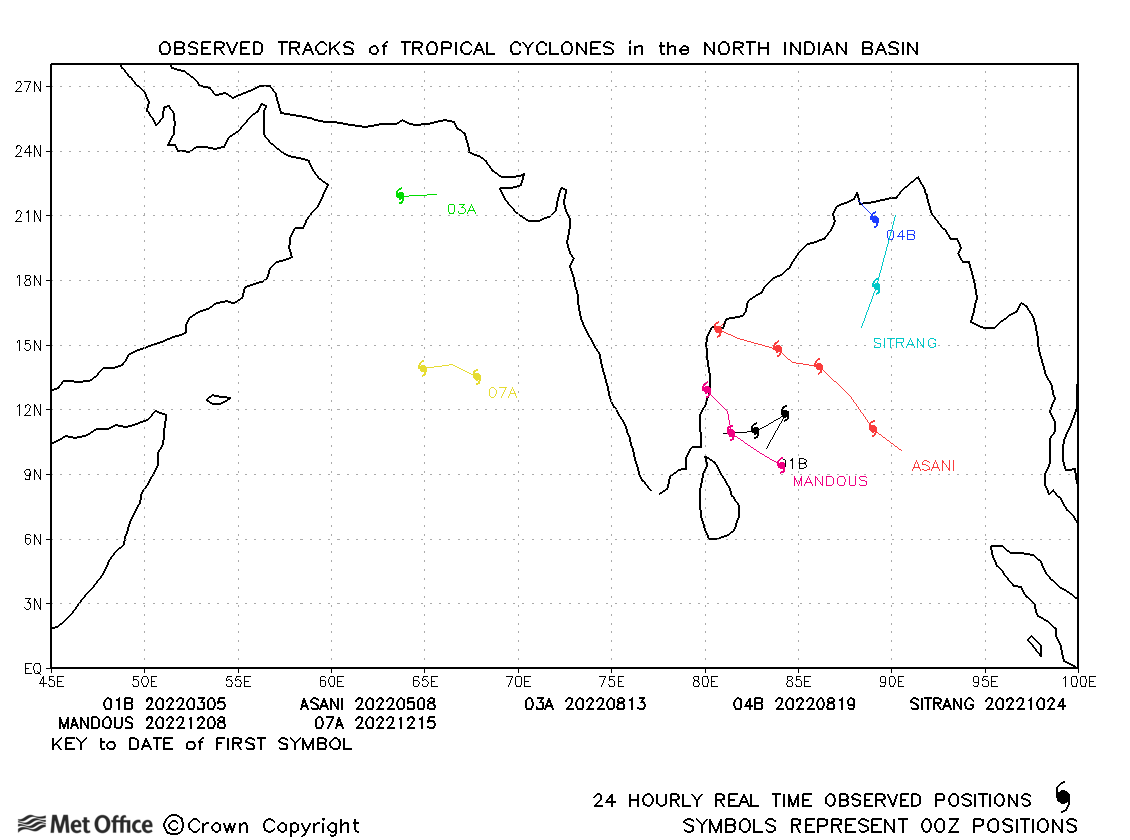
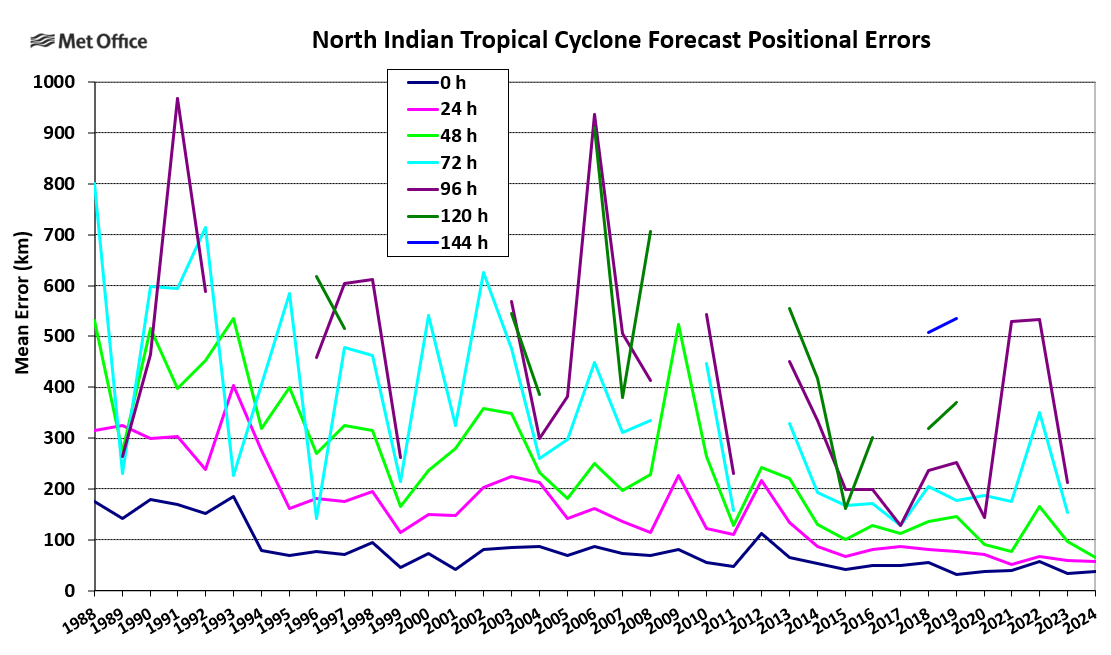
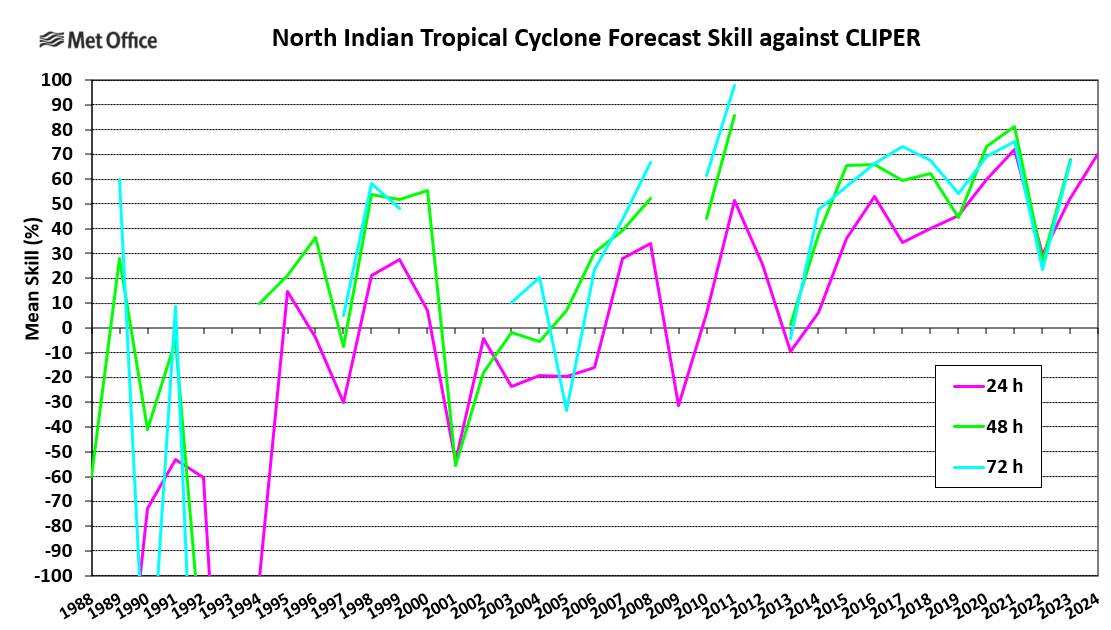
There were more storms than in 2021, but only one strong cyclone. Track forecast errors were high, but few forecasts were verified at longer lead times.
3.5 Combined statistics for whole northern hemisphere
| T+0 | T+24 | T+48 | T+72 | T+96 | T+120 | T+144 | T+168 | |
| Possibly verified | 468 | 345 | 253 | 175 | 120 | 80 | 47 | 25 |
| Detection rate (%) | 100 | 99 | 97 | 98 | 96 | 95 | 89 | 76 |
| AT error (km) | 1.7 | 2.5 | -4.9 | -23.2 | -39.2 | -56.8 | -94.4 | -405.2 |
| CT error (km) | -4.0 | 2.5 | -4.9 | -23.2 | -39.2 | -56.8 | -94.4 | -405.2 |
| Track skill (%) | ***** | 66.8 | 69.6 | 70.9 | ***** | ***** | ***** | ***** |
| * 2017-21 skill (%) | ***** | 61.9 | 69.4 | 70.1 | ***** | ***** | ***** | ***** |
| DPE (km) | 33.5 | 65.1 | 118.6 | 185.5 | 253.6 | 380.4 | 570.8 | 736.6 |
| * 2017-21 DPE (km) | 32.4 | 68.0 | 122.2 | 189.2 | 269.5 | 349.9 | 466.8 | 587.5 |
| Central pressure bias (mb) | 2.6 | 7.3 | 11.7 | 14.2 | 14.5 | 15.7 | 19.7 | 26.3 |
* 5-year running mean DPE and skill for all northern hemisphere storms for 2017-21
2022 saw a lower total number of tropical cyclones than 2021, but a larger number reached hurricane strength.
Track forecast errors were near to the 5-year running mean at short lead times, but higher at longer lead times. Cross track errors were mostly negative (left-of-track bias) by a small amount, as were the along track errors (slow bias). Detection percentages were mostly high, but dropped off at longer lead times.


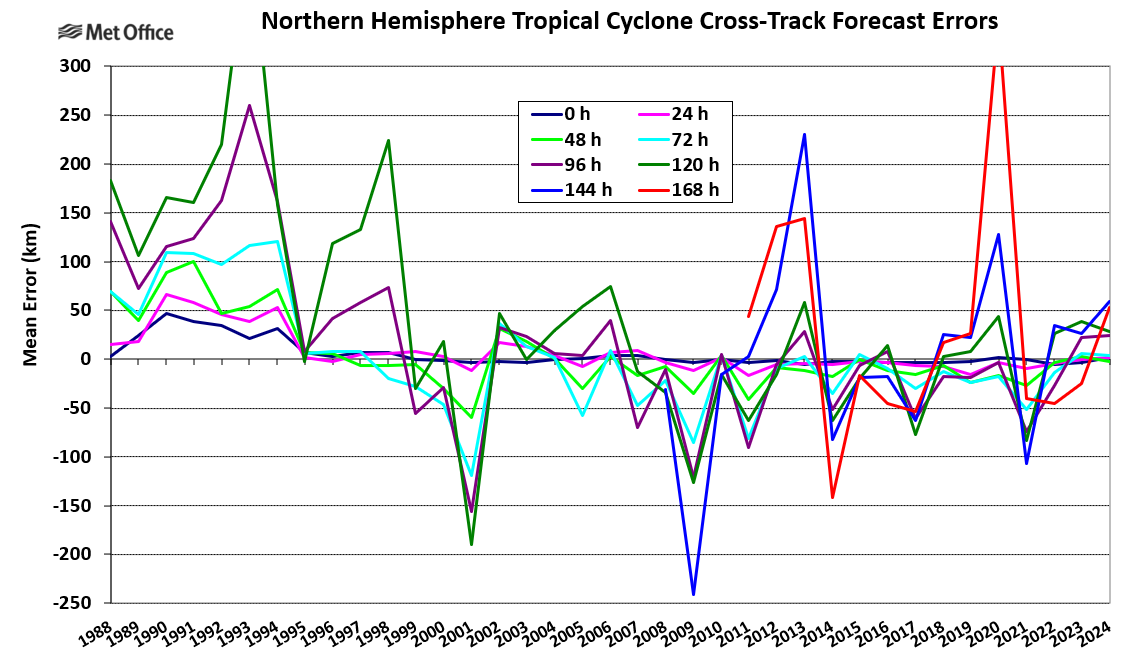
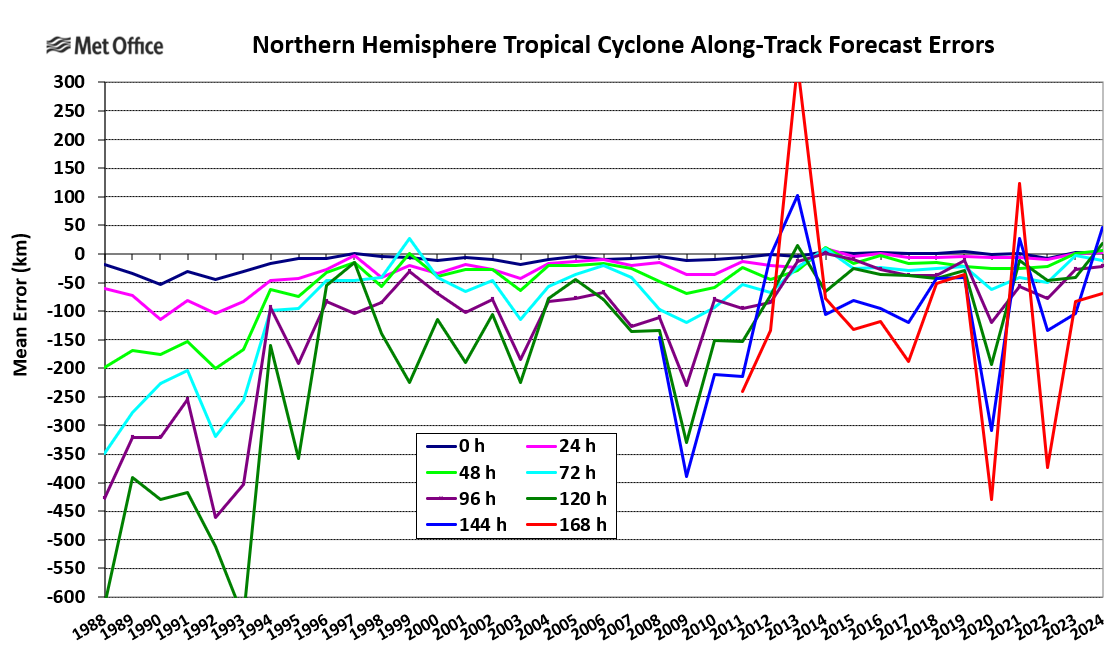
The 5-year running mean of track forecast errors continues to flat-line at most lead times, but is slightly increasing at longer lead times.
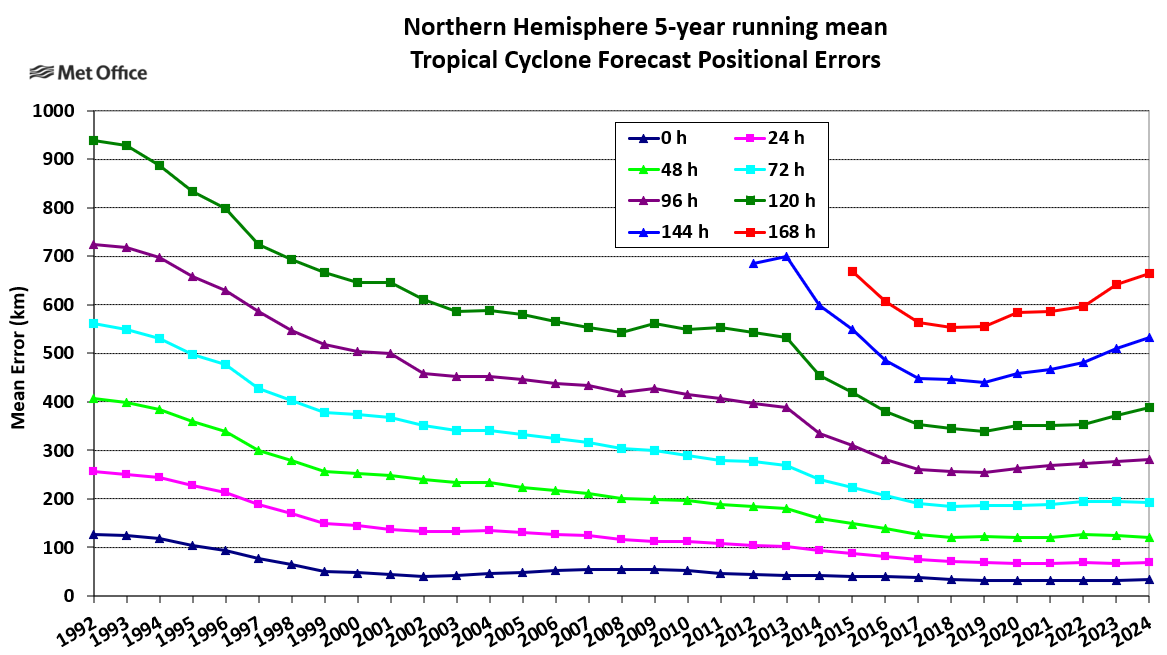
The intensity bias as measured by central pressure was positive (weak bias) and growing with lead time. Similarly 10m winds had a weak bias which increased with lead time. The intensity biases were much different to and worse than recent years following the introduction of global model configuration GC4 just before the main part of the season in May 2022.
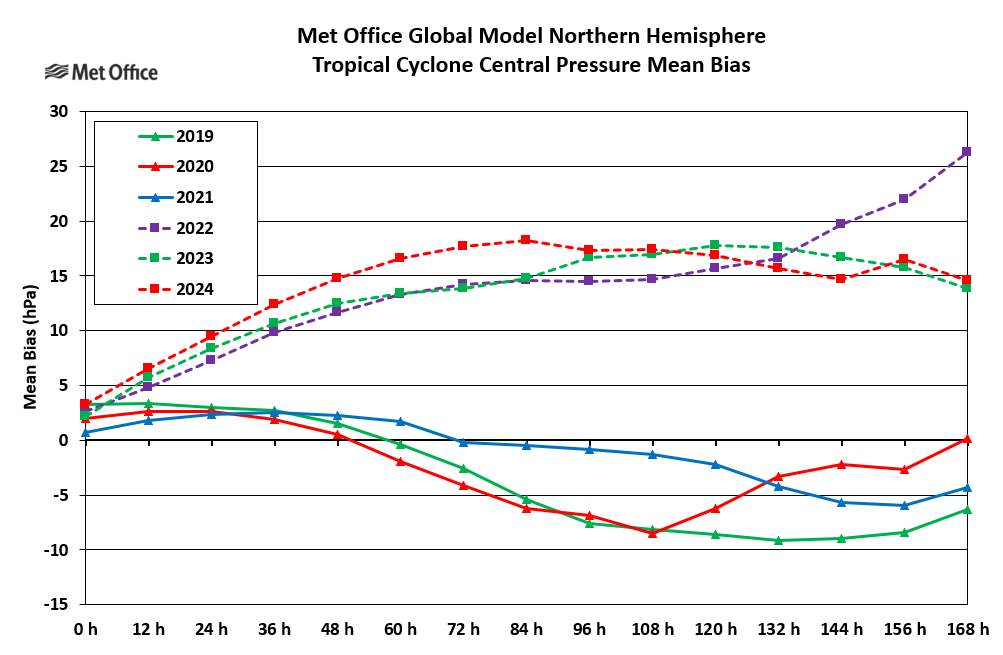
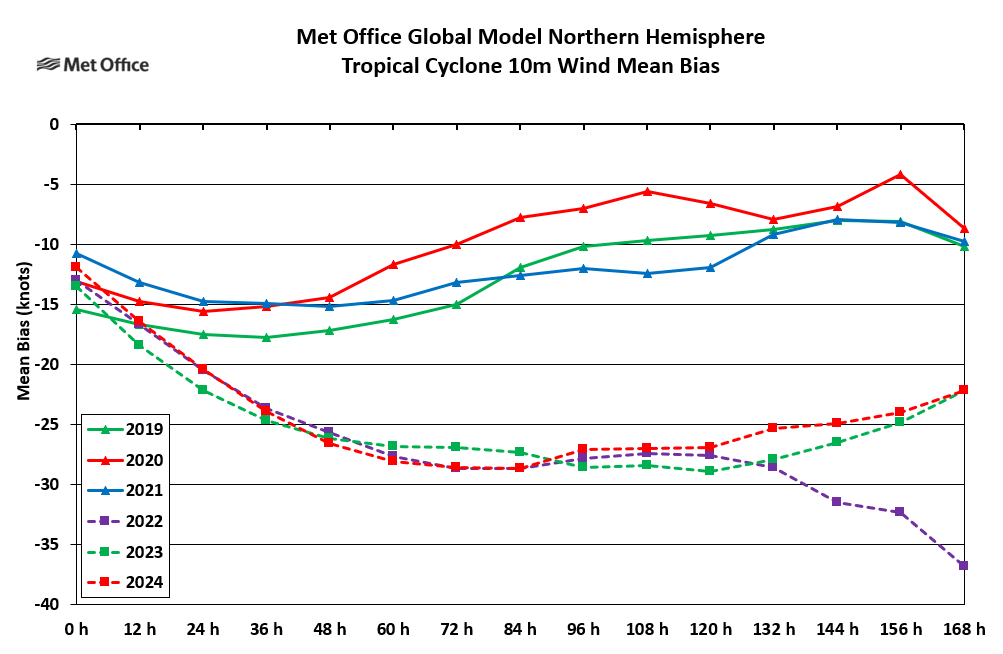
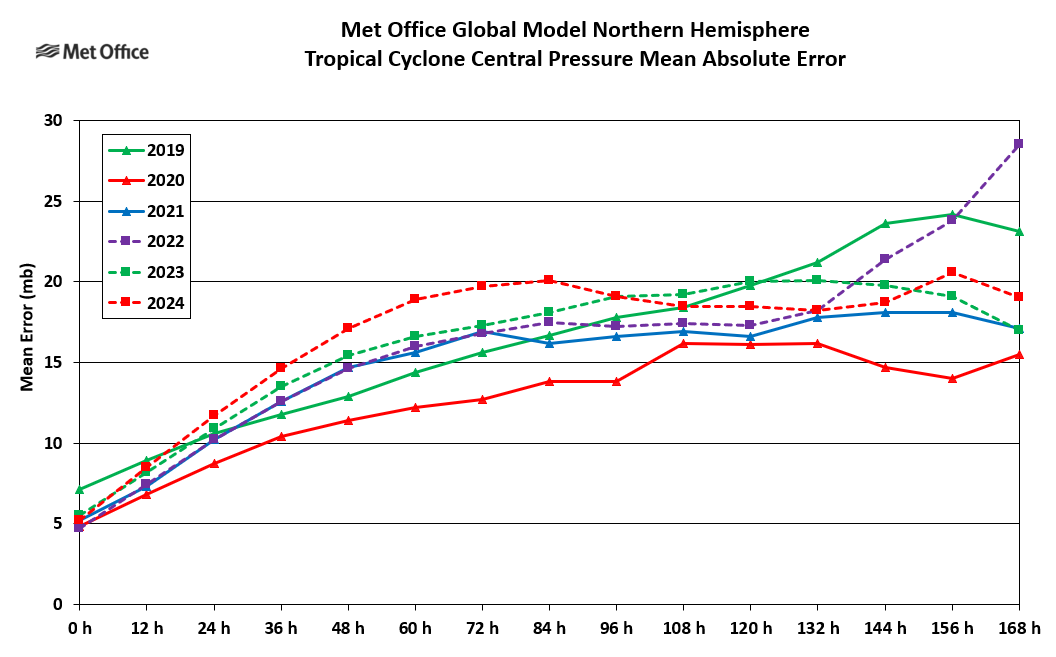
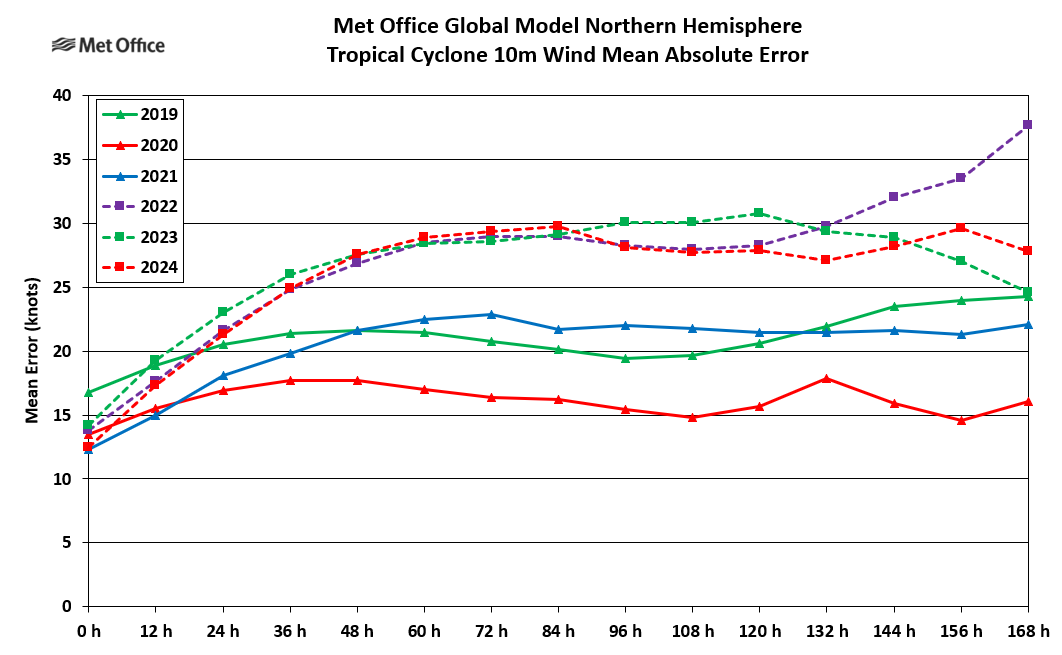
4. Further tropical cyclone information
The Met Office tropical cyclone web pages contain information on tropical cyclone forecasting at the Met Office. Summaries of tropical cyclone activity and forecasts are made at the end of each season, together with observed and forecast track information, track and intensity prediction error statistics, lists of names and real-time tropical cyclone forecast guidance.
For further information on tropical cyclone forecasting email the Met Office.



